Architecture of Madrid

The architecture of Madrid has preserved the look and feel of many of its historic neighbourhoods and streets, even though
The architecture of Madrid reflects a number of styles from various historical periods.
Medieval and Renaissance period
Very little medieval architecture is preserved in Madrid, and most of it is located inside the
Nor has Madrid retained many examples of Renaissance architecture, except for the
Habsburgs transform Madrid into a capital city
When Philip II moved his court to Madrid in 1561, a series of reforms began, reforms that aimed to transform the town into a capital city worthy of the name. These reforms were embodied in the
Many of the historic buildings of Madrid were built during the reign of the Habsburgs. The material used was mostly brick and the humble façades contrast with the elaborate interiors. Juan Gómez de Mora built notable buildings such as Casa de la Villa,
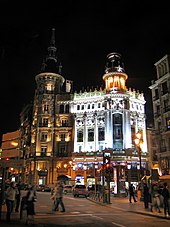
Pedro de Ribera was one of the most important architects in Madrid of the pre-Bourbon era. Ribera introduced Churrigueresque architecture to Madrid, characterized by ornamental overload on their covers, as an altarpiece. The History Museum, the Cuartel del Conde-Duque, the church of Montserrat and the Bridge of Toledo are the best examples.[citation needed]
The Bourbons
The arrival of the Bourbons marked a new era in the city. Ruins of the burned Alcazar of Madrid was replaced by the grand
King
Subsequently, the Peninsular War, the loss of colonies in the Americas, and the continuing coups prevented the city from developing interesting architecture (Royal Theatre, the National Library of Spain, the Palace of the Senate and the Congress). In the slums of Madrid during this time, a kind of substandard house was developed that today has a special historical charm: an example is the corralas, which currently still exist in the neighborhood of Lavapiés.
Modernization
From the late 19th century until the Civil War, Madrid modernized and built new neighborhoods and monuments, both in the capital and in neighboring towns. In the mid-19th century the expansion of Madrid developed under the
The
The last decade of the 19th century brought a Nationalist reaction in Architecture, represented in two revival styles: the neo-plateresque and the neo-baroque.[7] José Urioste Velada and José López Sallaberry were stand-out architects of the neo-plateresque. The former was the author of a number of monumental gates and following his comeback from Paris, many private houses, while the latter was the author of the Blanco y Negro Building at Serrano Street.[7] While chiefly developed in the early 20th century in Madrid, the neo-baroque was some of the last examples of 19th-century revivalist architecture. Some exponents of the style were Eduardo Reynals and Juan Moya Idígoras.[7]
Modernismo (the Spanish expression of
- Selection of works by Palacios in Madrid
-
ThePalacio de Comunicaciones
-
The Círculo de Bellas Artes
-
Banco del Río de la Plata
-
Casa Matesanz
-
Hospital de Maudes
Also the construction of
The Banco Bilbao was a notable case of late eclecticism in the 1920s, while the Palacete Cort and the Cine Doré were examples of late Secession in the city.[10]
Modesto López Otero, adept to historicist lines, projected the notable La Unión y el Fénix Español building, influenced by North-American architects practicing the Mission Style in vogue by that time in the United States.[11]
The 1936–1939 Civil War interrupted the road to Modernity.[12]
Francoist dictatorship

Soon after the entry of the Francoist troops in Madrid signalling the end of the war, the new Mayor exhorted to the Madrilenians not to rest until Madrid became the "capital worthy of the New Spain, One, Great and Free, of the Imperial Spain forged by the Generalísimo, by the Armed Forces, by the militias, and by the rearguard, through the means of steel, through the means of blood, and through sacrifices.[13]
Already in June 1939, a meeting of the Assembly of Architects presided by prominent Falangist architect Pedro Muguruza convened in Madrid, and a document about the General ideas on the National Plan for Planning and Reconstruction was delivered later in the year, setting the lines of the immediate post-war architecture.[14] According to Pedro Bidagor, the author of the 1941 urban planning for the city, in the new regime there was no more "freedom before the State to do the works according the anyone's humour; there is no freedom between good and evil. Is it mandatory to perform up to maximum effort and endure maximum discipline to do things right".[15] A Directorate-General for Architecture was created in September 1939 following totalitarian lines.[16]
In the first years of the Francoist dictatorship, the regime adhered to some elements of the totalitarian architectural language, with a folkish mythification of the works of Juan de Herrera and Juan de Villanueva, captured in buildings such as the Luis Gutiérrez Soto's Ministry of the Air, reminiscent of El Escorial. During these years, in the Spanish case the reactionary and Catholic conservative matrix largely prevailed over a purely Fascist architecture in the sense of the Roger Griffin's established link between modernity and Fascism.[17] The neo-herrerian style developed in the 1940s adapted in Spain the monumentality espoused by German and Italian fascist architectural styles, but it strayed from them in the sense that this style, very much looking to the past, remained far from the avant-garde.[18] The Teatro Clara Eugenia, a building strikingly following the style of Nazi's official architect Albert Speer was nonetheless erected in 1943 on the current day district of Hortaleza.[19]
- Instances of Early Francoism's historicism
-
Colegio Mayor San Pablo
-
Ministry of the Air
-
AECID headquarters
With the country ruined after the war, the
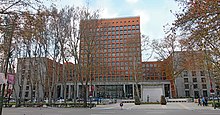
Nonetheless, these delusions of grandeur caught up with reality and the scarcity during the Post-War and most of the projects ended up either filed, unfinished or mutilated, with the single clear success being the Gutiérrez Soto's Cuartel del Ejército del Aire.[24]
A sense of modernity was nonetheless later introduced at some point, with buildings such as the Cabrero & Aburto's Casa Sindical or the headquarters for the Alto Estado Mayor de la Defensa, by Gutiérrez Soto,[17] that, particularly in the first case, decidedly broke with traditionalist historicism.
Recent architectural developments
1992 was a marked year for Spain. However, the Capital of Culture Madrid celebrated in 1992 did not have the meaning the Universal Exposition and the Summer Olympics had for Seville and Barcelona, respectively, and the city was left with no lasting icon of the year.[25] The most outstanding projects in the early 1990s were the reopening of the Museo Nacional Centro de Arte Reina Sofía (project by Antonio Fernández Alba) and the renovation of the Atocha Train Station (by Rafael Moneo).[25]
-
Expansion of Atocha by Rafael Moneo
-
Elevators of the Reina Sofía Museum

In the last quarter of the 20th century skyscrapers appeared in the city such as Torre Picasso, designed by Minoru Yamasaki; Torres Blancas and Torre BBVA (both by Francisco Javier Sáenz de Oiza) and in the 1990s, the Gate of Europe, architects Philip Johnson and John Burgee. Moreover, in the 1990s construction was completed of the Cathedral of the Almudena. The National Auditorium of Music is a work of 1988.
In the 21st century, Madrid faces new challenges in its architecture. An old industrial warehouse is the Interpretation Centre of New Technologies, and the CaixaForum Madrid (Herzog & de Meuron) was a former power station.
Under the government of
-
Gran Vía 48
-
Barajas' Terminal 4
-
Campus Repsol
-
Cristalia 4A
Sculpture
The streets of Madrid have many outdoor sculptures. The Museum of Outdoor Sculpture, located in the Paseo de la Castellana, is dedicated to abstract works, among which the Sirena Varada (Strander Mermaid) by Eduardo Chillida.
Since the 18th century, the
The equestrian sculptures are particularly important,[citation needed] starting chronologically with two designed in the 17th century: the statue of Philip III, in the Plaza Mayor by Giambologna, and the statue of Philip IV, in the Plaza de Oriente (projected by Velázquez and built by Pietro Tacca with scientific advice from Galileo Galilei).
Many areas of the
In another vein are the neon advertising signs, some of which have acquired a historic range and are legally protected, such as Schweppes in Plaza de Callao or Tío Pepe in the Puerta del Sol, recently retired from its location for the restoration of the building.
-
Fountain of Neptune (Ventura Rodríguez)
-
Fountain of Cybele(Ventura Rodríguez)
-
Monument to Alfonso XII (José Grases Riera)
-
Strander Mermaid (Eduardo Chillida)
-
Philip IV (Pietro Tacca)
-
Fuente del Ángel Caído (Ricardo Bellver)
Religious architecture
Catholic churches
Madrid has a considerable number of Catholic churches, some of which are among the most important Spanish religious artworks.
The oldest church that survives today is
The Bishop Chapel is a gothic chapel built in the 16th century by order of the Bishop of Plasencia, Gutierre de Vargas. It was originally built to house the remains of
-
Royal Convent of La Encarnación (façade)
-
Colegiata de San Isidro
-
Basílica de San Francisco el Grande
The
In the church are preserved shrines containing the blood of
The interior of the church has been restored, and includes several frescoes painted by Luca Giordano, Francisco Carreño, and
The
-
Almudena Cathedral is the current cathedral.
-
Church of Santa Cristina (Neo-Mudéjar)
-
Basílica de la Milagrosa (Gothic Revival)
-
Church of Nuestra Señora de Guadalupe (a postconciliar church)
The church is dedicated to
The
Bridges, viaducts, water supply and tunnels
There is no evidence of the existence of bridges over the Manzanares during the time of al-Andalus (fords and pontoons were used instead).[28] There was a small "alcantarilla" (small bridge) crossing a creek that ran along what it is now the Calle de Segovia.[28] Some bridges (thought to be not particularly sound, as the chronicles mentioned the frequent repairs after river floods) were built as the city developed after the Christian conquest in the 11th century.[29] The first mentions to bridges were the puente Toledana and the puente Segoviana across the Manzanares and the puente de Viveros across the Jarama (located far from the city in the latter case),[30] but until Madrid did not become capital of the Habsburg Dynasty in the 16th century, no steady bridges able to resist the seasonal rise of the Manzanares were built.[29]
-
Puente de Segovia
During the reign of
Since the foundation of the city in the 9th century until the 19th century the viajes de agua (viage in Archaic Spanish), following the Persian technology of the Qanat introduced by the Muslims in the Iberian Peninsula in the 8th century, were the single infrastructure for water supply in the city.[33] The viajes comprised a network of draining wells and galleries, a conduction underground gallery and a network for distribution.[34] However the first written mentions of the viajes trace back to the early 13th century, during the Christian period in the Middle Ages.[35] By the middle of the 19th century, the network of viajes extended more than 124 km in length, the most important ones being those of Alto Abroñigal, Bajo Abroñigal, Alcubilla, Amaniel and Fuente Castellana.[36]
In the 19th century, the problems posed by water supply as the population increased, led to the construction of the
See also
References
- Citations
- ^ "Arquitectura. Edificios de los Museos Estatales". Mcu.es. 25 January 2012. Retrieved 7 August 2012.
- ^ "Geography of Madrid". Easy expat. 11 August 2006. Archived from the original on 22 July 2012. Retrieved 9 January 2015.
- ^ "Plaza de Cibeles | Spain.info in English". Spain.info. Retrieved 7 August 2012.
- ^ "Madrid's Palacio de Cibeles Renovated Into Jaw-Dropping CentroCentro Cultural Center | Inhabitat – Sustainable Design Innovation, Eco Architecture, Green Building". Inhabitat. Retrieved 7 August 2012.
- ^ "Cibeles Fountain – Tourism in Madrid". Turismomadrid.es. Archived from the original on 18 December 2012. Retrieved 7 August 2012.
- ^ San Antonio Gómez, Carlos de (2008). "La arquitectura de Madrid: de la Restauración al fin de siglo" (PDF). Conferencias sobre Arquitectura y espacio urbano de Madrid en el siglo XIX. p. 90.
- ^ Navascués Palacio, Pedro (1976). "Opciones modernistas en la arquitectura madrileña" (PDF). Pro-Arte (5): 29–33.
- ^ Pérez Rojas, Francisco Javier (1985). "Antonio Palacios y la arquitectura de su época" (PDF). Villa de Madrid (83): 4.
- ISBN 84-451-1742-4.
- ^ San Antonio Gómez 1998, pp. 21–22.
- ^ Larson 2003, p. 396.
- ^ Box 2012, p. 165.
- ^ Box 2012, p. 156.
- ^ Box 2012, p. 157.
- ^ Box 2012, pp. 158–159.
- ^ a b López Díaz 2014, pp. 244–249.
- ^ Gosálvez, Patricia (17 January 2017). "Los delirios de la arquitectura franquista". El País.
- ^ Prieto, Carlos (4 April 2017). "Teatro Clara Eugenia: el edificio más nazi de España está en un parque perdido de Madrid". El Confidencial.
- ^ Box 2012, pp. 151–154.
- ^ Box 2012, pp. 166–167.
- ^ Box 2012, pp. 175–176.
- .
- ^ Box 2012, pp. 170–172.
- ^ a b Larson 2003, p. 397.
- ^ Larson 2003, p. 399.
- ^ Valls, Fernando H. (9 July 2020). "Ayuso acelera Madrid Nuevo Norte y se prepara para empezar a 'mover tierras'" (in Spanish). La Información. Retrieved 11 July 2020.
- ^ a b Morales Segura et al. 2000, p. 706.
- ^ a b Morales Segura et al. 2000, pp. 705–706.
- ^ Morales Segura et al. 2000, pp. 706–707.
- ^ Corella Suárez 2004, p. 237.
- Ayuntamiento de Madrid. Área de Gobierno de las Artes. Dirección General de Infraestructuras Culturales.
- ^ Guerra Chavarino 2006, pp. 420–421.
- ^ Guerra Chavarino 2006, p. 423.
- ^ Guerra Chavarino 2006, pp. 421–422.
- ^ Guerra Chavarino 2006, p. 424.
- ^ Bonet Correa 2002, p. 39.
- ^ Bonet Correa 2002, p. 43.
- ^ Bonet Correa 2002, pp. 49–50.
- Bibliography
- Bonet Correa, Antonio (2002). "Madrid y el Canal de Isabel II". Arbor. 171 (673). Madrid: ISSN 0210-1963.
- Box, Zira (2012). "El cuerpo de la nación. Arquitectura, urbanismo y capitalidad en el primer franquismo (1)". ISSN 0048-7694.
- Corella Suárez, Pilar (2004). "Dibujos para el puente de Segovia de los siglos XVII y XVIII" (PDF). Anales del Instituto de Estudios Madrileños. XLIV. Madrid: Consejo Superior de Investigaciones Científicas: 237–248.
- Guerra Chavarino, Emilio (2006). "Los viajes de agua de Madrid" (PDF). Anales del Instituto de Estudios Madrileños. XLVI. Madrid: ISSN 0584-6374. Archived from the original(PDF) on 2019-09-20.
- Larson, Susan (2003). "Shifting modern identities in Madrid's recent urban planning, architecture and narrative". Cities. 20 (6): 395–402. .
- Morales Segura, Mónica; Núñez Martí, Paz; Pérez Velasco, Eva; Segura Graiño, Cristina (2000). "Los puentes de Madrid en la Edad Media. Construcción y reconstrucciones" (PDF). In E. Rabasa, M. Tabales (ed.). Actas del Tercer Congreso Nacional de Historia de la Construcción, Sevilla, 26-28 octubre 2000, eds. A. Graciani, S. Huerta. Madrid: Instituto Juan de Herrera, SEdHC, U. Sevilla, Junta Andalucía, COAAT Granada, CEHOPU. pp. 705–709.
- Navascués Palacio, Pedro (1973). Arquitectura y arquitectos madrileños del siglo XIX (PDF). Madrid: Instituto de Estudios Madrileños. ISBN 84-500-5868-6.
External links
![]() Media related to Architecture of Madrid at Wikimedia Commons
Media related to Architecture of Madrid at Wikimedia Commons

![Casa de los Lujanes [es]](http://upload.wikimedia.org/wikipedia/commons/thumb/8/8f/Casa_y_Torre_de_los_Lujanes_%28Madrid%29_03.jpg/305px-Casa_y_Torre_de_los_Lujanes_%28Madrid%29_03.jpg)









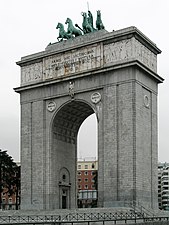



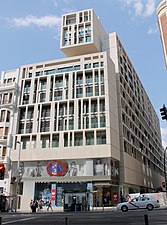
![Ciudad BBVA [es]](http://upload.wikimedia.org/wikipedia/commons/thumb/e/ec/BBVA_head_offices_%28Madrid%29_09.jpg/184px-BBVA_head_offices_%28Madrid%29_09.jpg)










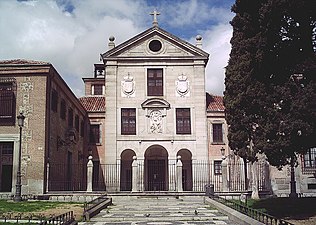









![Puente de los Franceses [es]](http://upload.wikimedia.org/wikipedia/commons/thumb/b/b5/Puente_de_los_Franceses_%28Madrid%29_01.jpg/300px-Puente_de_los_Franceses_%28Madrid%29_01.jpg)
![Puente de Toledo [es]](http://upload.wikimedia.org/wikipedia/commons/thumb/3/3c/Un_paseo_a_media_tarde_por_los_alrededores_del_r%C3%ADo_Manzanares_%2814170903005%29.jpg/337px-Un_paseo_a_media_tarde_por_los_alrededores_del_r%C3%ADo_Manzanares_%2814170903005%29.jpg)
![Puente de Arganzuela [es]](http://upload.wikimedia.org/wikipedia/commons/thumb/0/04/Detalle_exterior_pilas_cimentaci%C3%B3n.jpg/338px-Detalle_exterior_pilas_cimentaci%C3%B3n.jpg)